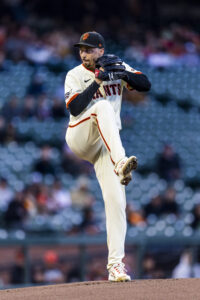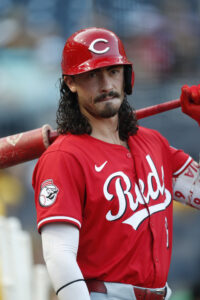The Dodgers continue to load up, as they announced their five-year contract with left-hander Blake Snell Saturday afternoon. The deal, which is pending a physical, comes with a $182MM guarantee but reportedly includes $65MM in deferrals ($13MM per year) that’ll reduce the net present value to the $160-165MM range. Snell, a client of the Boras Corporation, receives a $52MM signing bonus and limited no-trade protection, while the deal includes a $5MM assignment bonus in the event of a trade. The contract does not contain any opt-out provisions and covers Snell’s age 32-36 seasons.
It’s the offseason’s biggest move to date and represents a much quicker resolution than Snell’s previous trip to the market. The star southpaw was coming off a Cy Young campaign last winter. The long-term deal he sought didn’t materialize, leading to an extended free agent stay. Snell went unsigned into March before joining the Giants on a two-year deal that guaranteed him $62MM and, more importantly, allowed him to opt out after the first season.
Snell had a dismal start to the season. He allowed more than a run per inning over his first six appearances. He landed on the injured list twice in the first three months while battling groin discomfort. As recently as the middle of June, it looked like a near-lock that Snell would bypass the chance to return to free agency.
That all changed as soon as he returned from his second IL stint. By the end of the season, there was no doubt he’d pass on the remaining $30MM on his pact with San Francisco. Snell was the best pitcher in baseball down the stretch. Over his final 14 starts, he turned in a 1.23 earned run average while holding opponents to a .123/.211/.171 batting line that looked like a throwback to the days when pitchers hit.
Snell struck out more than 38% of batters faced over that run. He had five double-digit strikeout performances and fanned at least eight hitters in 10 outings. Snell had the best two-start run of his career right around the trade deadline. He struck out 15 over six scoreless innings against the Rockies on July 27 before no-hitting the Reds with 11 punchouts on August 2.
The overall numbers were still weighed down to some extent by his terrible first two months. He wrapped up the year with a 3.12 ERA and a 34.7% strikeout rate over 104 innings spanning 20 starts. That’s a strong season but didn’t earn him a single Cy Young vote. The overall platform year was less impressive than the 180 innings of 2.25 ERA ball he posted during his ’23 campaign in San Diego. Snell finished the season looking every bit as dominant as he’d been during his Cy Young years, though.
It seems the Dodgers are attributing the first two months to some combination of an abbreviated Spring Training and the injuries. While this year was the most extreme example, Snell has been a slow starter throughout his career. He has a 3.95 ERA and 28.4% strikeout rate in the first half of his nine big league seasons. The ERA plummets to 2.39 while he has raised his strikeout percentage above 32% after the All-Star Break.
The main knock has been his lack of consistent durability. Snell has reached the 180-inning threshold on two occasions — his 2018 Cy Young season with the Rays and his ’23 award-winning campaign. Outside those seasons, Snell has topped out in the 125-130 inning range.
That’s not a concern for the Dodgers, who have shown they’re far more interested in chasing upside than bulk. Los Angeles acquired and extended Tyler Glasnow last offseason even though he’d never topped 120 MLB innings in a season. The Dodgers will give Shohei Ohtani another chance to pitch coming off his second significant elbow surgery. They’re almost certainly going to reunite with Clayton Kershaw. They’ve graduated a number of talented pitchers from the farm system but seen a lot of them go down to injuries.
It’s an approach geared heavily toward the postseason. The Dodgers prioritize pitchers who profile as potential Game 1 starters. They’re very willing to assume injury risk while chasing that ceiling. That left them woefully short on starting pitching in 2023, resulting in a sweep at the hands of the Diamondbacks in the Division Series. The injuries mounted again this fall, but they had just enough in the form of Yoshinobu Yamamoto, Jack Flaherty and Walker Buehler to patch together an October rotation. With a star-studded lineup, that was sufficient to lift their second trophy in five years.
Snell arguably fits that mold as well as any pitcher in baseball. Among pitchers with at least 200 innings over the past two years, only Reynaldo López and Tarik Skubal have a lower ERA than his 2.57 mark. Snell’s 32.7% strikeout rate is second, trailing only Glasnow by a fraction of a percentage point. No one has a higher swinging strike rate.
The Dodgers have four pitchers who could start the first game of a playoff series. Snell, Ohtani, Yamamoto and Glasnow are each capable of providing ace-caliber production on a rate basis. It’s unlikely all four will be healthy come playoff time, but the Dodgers have no shortage of talented options behind them. Kershaw figures to be back in the rotation mix once he re-signs, while Tony Gonsolin, Dustin May and prospect Nick Frasso are returning from major surgeries. Bobby Miller is looking to rebound from a terrible sophomore season after turning in a 3.76 ERA across 22 starts as a rookie. Landon Knack and Justin Wrobleski are capable depth arms.
That’s before considering the possibility of further acquisitions. The Dodgers will surely make a push for NPB ace Roki Sasaki, who’d arguably be the fifth starter if he went to L.A. Even if Sasaki signs elsewhere, the Dodgers could pursue Garrett Crochet on the offseason trade market and/or continue adding starting pitching at the deadline.
Of course, the ability to stockpile this kind of rotation talent is a reflection of the Dodgers’ financial might. Even if other front offices share their general approach to valuing upside over durability, few ownership groups are willing to match L.A.’s spending. The Dodgers had generally shied away from pitching splashes under president of baseball operations Andrew Friedman, but that has changed over the past calendar year. This is their third nine-figure pitching investment since last offseason (fourth including Ohtani). They signed Yamamoto for $325MM and extended Glasnow on a deal that included $110MM in new money.
MLBTR ranked Snell as the #2 starting pitcher in the class and predicted a five-year, $160MM contract. The deal’s actual value lands right around there. The specific NPV won’t be clear until the deferral structure is revealed. The expected $32-33MM luxury tax hit indicates the deal will have a net present value in the $160-165MM range. That’d be the second-biggest luxury tax hit on L.A.’s books, trailing only the approximate $46.1MM CBT number on Ohtani’s heavily deferred $700MM contract.
In any case, the deal is likely to push the Dodgers’ competitive balance tax figure north of $300MM. They’ll almost certainly land in the fourth and final tier of penalization, which begins at $301MM. The Dodgers are subject to the highest tier of escalation penalties for paying the tax in at least three straight seasons. The Snell deal itself will cost the Dodgers something in the range of $25-30MM in taxes by vaulting them from the middle of the second penalization tier to the start of the highest tax bracket. Future spending will be taxed at the maximum 110% clip.
It’s a major commitment but one the Dodgers are well-positioned to make. They’re coming off the revenue bump associated with a World Series win. More importantly, the structure of Ohtani’s contract allows the Dodgers to continue stockpiling talent. While the Ohtani deal was not an end-around the luxury tax, there’s a huge benefit from a raw payroll perspective. Paying the NL MVP a $2MM salary for the next nine seasons is a big reason they’re able to continue taking on huge money in the short term.
Snell slotted alongside Corbin Burnes and ahead of Max Fried as the top starters in this year’s class. In addition to fitting the Dodgers’ general preference for high-ceiling arms, Snell came with the benefit of not costing draft compensation. He’s the only of the top three starters who wasn’t issued a qualifying offer. Snell had received the QO during his first free agent trip, so the Giants could not make the offer this time around. Burnes and Fried each rejected a qualifying offer and would’ve cost the Dodgers their second- and fifth-highest selections in the 2025 draft and $1MM from their ’26 bonus pool for international amateurs.
Burnes and Fried become the clear #1-2 options for the other teams seeking top-flight starting pitching. Mark Feinsand of MLB.com reported this evening that the Red Sox, Yankees and Orioles were also in the Snell bidding. They’ve all been tied to top-of-the-market starting pitchers — Boston especially — and should remain active on that front in the weeks to come.
MLB.com’s Mark Feinsand reported the Dodgers and Snell had a five-year deal, shortly after the pitcher revealed on Instagram that he was joining L.A. Jeff Passan and Jorge Castillo of ESPN first reported the $182MM guarantee. Fabian Ardaya of the Athletic reported that the deal contained deferrals that would drop the net present value to the $32-33MM range annually. Jack Harris of the Los Angeles Times was first with the $52MM signing bonus, while Feinsand had the limited no-trade protection. Jon Morosi of the MLB Network reported the absence of an opt-out clause. Jon Heyman of the New York Post first reported the presence of an assignment bonus, which Harris relayed at $5MM. Heyman first reported the exact breakdown of the deferrals.
Image courtesy of USA Today Sports.

 The
The 




